I’m a pretty low-maintenance guy, obviously. This translates to my approach across a lot of stuff—living space, cooking and my clothes.
I’m casual in general—and living in a small space doesn’t offer room for a walk-in closet or a giant sneaker collection. In fact, about a year ago I realized I’d inadvertently started wearing a basic “uniform” of sorts: white undershirt, charcoal grey t-shirt, shorts, underwear, socks, sneakers. I was tired of having to think about what to wear. I was looking for something I could throw on and go. For most occasions, this fit the bill.
It turns out a lot of people have embraced a minimalist philosophy when it comes to getting dressed. With so many decisions to make and so much noise going on around us, having a basic, minimalist wardrobe just works. It’s one less piece of the puzzle to worry about. No more stress in the morning when you get dressed. You don’t even have to think!
Now, maybe you don’t live in a rural tiny house, but an apartment in the city (just try to find a spacious closet in DC, New York or Chicago—you won’t). Even if you work a 9-to-5 office job, you can still make a minimalist wardrobe work. For guys, it’s as simple as changing out your ties and dress shirts. Even women can get by with a minimalist wardrobe. No matter what your job or lifestyle, there’s a way to embrace fewer clothes while still looking good.
So, how do you apply a minimalist philosophy to your own wardrobe? Should you throw out your clothes and start from scratch? Swear off shopping forever? Or should you buy every piece on a capsule wardrobe list?
A Minimalist Wardrobe Starts in Your Shrinking Closet
When someone mentions minimalist style, visions of stark white outfits come to mind or maybe rows of black turtlenecks. In truth, there’s no style rule to embracing a minimalist wardrobe, but it does begin with paring down your closet.
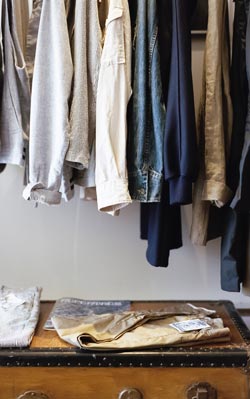 If you went through your closet right now, how many pieces have you worn in the last week? Month? Six months? Most of us would come up with around 20 pieces of clothing, maybe fewer. According to a study from clothing credit company (Alliance Data), the average American estimates their closet is worth around $2,500 with 25-49 tops and over 25 pair of shoes.
If you went through your closet right now, how many pieces have you worn in the last week? Month? Six months? Most of us would come up with around 20 pieces of clothing, maybe fewer. According to a study from clothing credit company (Alliance Data), the average American estimates their closet is worth around $2,500 with 25-49 tops and over 25 pair of shoes.
That’s a lot of clothes.
Most people’s closets benefit from refinement and simplification. When I realized that without even thinking about it I’d come up with my default wardrobe, it was actually a relief. Cross that one off the list—I went the way of Barack Obama, Mark Zuckerberg and others who’ve embraced a uniform approach to dressing. I realize this approach isn’t for everyone—you may want a little more variety. There are still plenty of options for a minimalist wardrobe without sticking to the same outfit every day.
But many people have closets full of clothes they never wear. In fact, most people only wear about 20% of their clothes. But, they hold on to clothes they don’t love, items that don’t flatter and outfits with sentimental attachment rather than function. If you’ve got a closet full of clothes, but still feel like you’ve got nothing to wear first step is to do a hard inventory.
Remove all the clothes from your closet and review each piece. Ask yourself the following:
- Favor: Do I really like this?
- Fit: Does it fit me right now, today?
- Function: Is this piece functional?
- Flatter: Do I feel great when I wear this?
- Form: Is this item in good shape and condition?
Ask yourself if each item in your closet meets these criteria. Once you’ve refined your wardrobe, consign or donate any items that don’t fit the bill. It feels tough to part with items you’re holding onto for sentimental reasons but remind yourself—you can still hold onto to memories and let go of stuff that’s no longer useful. There’s no reason to weigh yourself down.
When you’ve cleaned out your closet to the basics, here the steps to take as you move forward.
Choose a Color Scheme That Speaks to You
For me, charcoal grey looks presentable enough for most occasions. Black gets dirty too easily and white obviously is a no-go. Khaki or denim shorts and pants are tough enough to withstand almost any task. Yet they still look nice enough to grab dinner with friends. Women, you may find a different combination works for you—like jeans or black pants with knit tops. The point is to keep it simple and go with a color scheme you like.
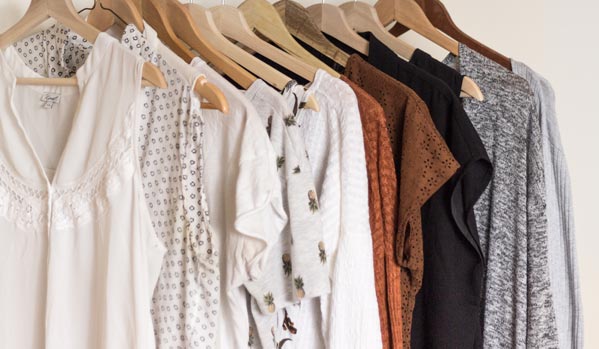
You may find there’s a color that really speaks to you or forms the foundation of most of your outfits. If this is the case, make it your default color. This doesn’t mean rows of black or sticking to neutral colors. If you love shades of blue, green or red, embrace it!
The idea with a color scheme is most of your pieces become interchangeable. Choosing pieces that look great with brown and earth tones, or going for high-contrast colors that look great against black, is a method to ensure plenty of wearability. If patterns are your jam, go for it! You can have patterned ties or shirts that will still fit with the overall color scheme you’ve selected. You aren’t limited to solids, unless they fit your personal style.
If you still want to show personality with your style, it’s easy with shoes, a cool belt or watch. Pick something you love as your “signature piece.” I’ve found having a go-to favorite pair of sneakers feels like “me.” For you, maybe it’s a watch or another functional-yet-fashionable item. Don’t shy away from buying a select few high-quality accessories that you love.
When you work within a color scheme everything goes. Remember:
- Pick a color you like
- Build your wardrobe around it
- Shop within your color scheme for new items to add
- Mix and match for variety
Basics Provide the Foundation of a Minimalist Wardrobe
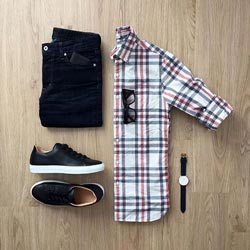 At the foundation of a minimalist wardrobe are basic pieces. For that reason, a capsule wardrobe goes hand-and-hand with minimalism. Still, you aren’t limited to following an exact capsule wardrobe list. After all, suits, blazers and trench coats are great for city-dwelling professionals, but I can’t imagine sweeping the snow off my solar panels while wearing a suit. For me, a suit would be ridiculous and impractical. At the same time, showing up for a banking job wearing a t-shirt might get you fired.
At the foundation of a minimalist wardrobe are basic pieces. For that reason, a capsule wardrobe goes hand-and-hand with minimalism. Still, you aren’t limited to following an exact capsule wardrobe list. After all, suits, blazers and trench coats are great for city-dwelling professionals, but I can’t imagine sweeping the snow off my solar panels while wearing a suit. For me, a suit would be ridiculous and impractical. At the same time, showing up for a banking job wearing a t-shirt might get you fired.
There’s no one-size-fits-all for your wardrobe. A fitness instructor may need yoga and gym gear. A construction worker may need Carhart overalls and quality t-shirts. If you work in a casual, creative office, a black t-shirt and jeans might be fine. Keep in mind, for formal occasions you can always rent a tux or for you ladies they have several dress rental options. (This works well for me personally, so I recommend giving it a try.)
Create a list of what you consider “basics.” For most of us that’s something on the bottom and something on the top. Imagine what you’d need for a two-week period (the maximum time most of us go between laundry cycles), assuming you wear bottoms and outer-layers, multiple times. Plan for the occasions your regularly face (work, school, the gym). This forms the base of your wardrobe.
Truly, there’s no hard-and-fast rule to tell you exactly what clothing you will need. Depending on your location, the weather may also play a huge factor in your choices too. In Minnesota, you may need extra winter layers. In California, light easy t-shirts could be enough. Plan for clothes that fit your lifestyle.
- Consider all the activities you need to dress for: work, home, hanging out
- Write up your basic list: tops and bottoms needed for two weeks
- Remember seasonal items like jackets, long underwear, sweaters or tanks
- Include items for work or other activities
Functional Footwear
Shoes take up a lot of space—space you might not have. The best way to get around the shoe issue is to buy the most functional shoes possible. For you, this could mean a pair of basic black sneakers to go from the office to the gym to weekends. Others might prefer boots. If you live in a rainy area, you might need GORE-TEX or waterproof footwear.
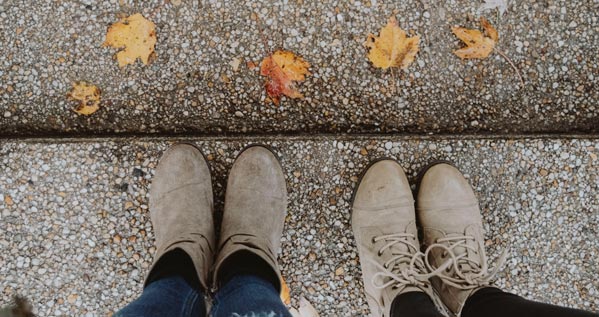
Having a pair of sandals in the summer won’t take up too much space or derail your wardrobe choices, but keep in mind—sandals aren’t always the best choice for doing work outside. If you’re hauling brush, working on repairs or even on a hike, you’ll need a pair of shoes that’s a bit sturdier. So, if space is a premium, skip the sandals.
For me, a couple pairs of shoes are all I need. When you consider your list of activities, you might also want to consider what sort of footwear you’re going to need in each occasion—work, gym, weekends and more.
Choose shoes in dark colors (unless you love white sneakers). They’re easier to keep clean and will go with more outfits and fit more occasions. When it comes to shoes if you’re only going to own a pair or two, go ahead and invest in something descent that will last.
- Look for functional footwear
- Choose only the number of pairs you really need
- Don’t choose sandals if you don’t have space—pick a more functional shoe
- Invest in quality
Buy Less and Buy Quality
Going forward, commit to buying fewer clothes and shopping for quality first. When you need a piece of clothing, shop for items that are well-made, functional and fashionable. Quality natural fabrics such as wool, cotton, hemp, bamboo and linen, often outlast man-made fabrics like polyester, rayon, acrylic and nylon.

Look for craftsmanship and detail when it comes to clothing. There’s a reason vintage coats from the 50s are still found in thrift stores—they were built to last. Often, they had features like linings, hand-stitching and other details you can’t find in mass-production.
Even if you’re buying t-shirts and jeans, it’s wise to look for quality and durability. I like pieces that will stand up to quite a bit of activity and many washings. A great aspect of a minimalist wardrobe is it often consists of one or two colors. This makes laundry much simpler than sorting each piece. Laundry is especially a challenge in small spaces, so look for clothes you can wear multiple times and line-dry.
When you’re shopping for clothes look for care-needed, quality of materials and guarantees. Yes, quality clothing is often pricier, but the number of wears will soon mean the piece pays for itself.
- Buy quality built-to-last clothing
- Look for natural clothes in cotton, hemp, etc.
- Find clothes in one color scheme to make laundry simple
Repair, Alter and Care
One way to preserve your investment is to learn to do minor repairs, alterations, proper storage and care. If you take the time to iron a hem or polish a shoe it has a huge impact on your look. Clean, pressed and well-kept clothing will help you feel put-together, even if it’s an outfit on heavy rotation.
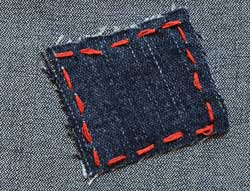 Now, admittedly, I don’t iron. I hate folding and sorting laundry, so using a laundry service is well-worth the investment for me. For most situations, I don’t need to show up in starched and pressed shirts and ties—but perhaps you do, so plan accordingly.
Now, admittedly, I don’t iron. I hate folding and sorting laundry, so using a laundry service is well-worth the investment for me. For most situations, I don’t need to show up in starched and pressed shirts and ties—but perhaps you do, so plan accordingly.
Take a lesson from previous generations who knew the value of careful handwashing, line-drying and separating laundry. When you have fewer clothes to care for, the laundry and clothing care because less stressful. Check over items before you hang them—look for loose buttons, hems and threads. Take the time to properly store your clothes and patch or sew up if needed—you can find basic tutorials on YouTube.
If you find a great, well-made item of clothing that doesn’t quite fit, invest in tailoring. This is even worth it for items like bib overalls, if they’re too long. Having pants hemmed so they don’t drag or taking them in at the waistline is worth it. They’ll be more comfortable and last much longer. Often minor alterations are all it takes to help an item fit like a glove and look like a million bucks. These small touches will greatly extend the life of your investments.
- Learn to do basic repairs and touch up your clothes
- Look over clothes for issues before you hang
- For nicer clothes like jackets, tailoring is worthwhile
Clean Your Closet Frequently
Remember the five “Fs” of closet sorting: favor, fit, function, flatter and form. Apply them to your wardrobe frequently—at least a couple of times a year. When something isn’t needed anymore, don’t feel bad about saying goodbye.
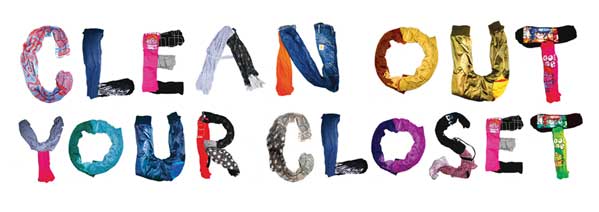
Clothes often build up over time. At one point everything fit in your closet perfectly and then one day you realize you’re holding on to more socks than fit in your drawer. Adopt a “one-in, one-out” mentality when it comes to buying clothing. If you need a new pair of running shoes, it’s time to let go of your old broken-down pair and start fresh.
Let go of stuff you don’t need rather than letting it weigh you down. Sometimes getting rid of clothes can help you clear your mental roadblocks as well. Consider the person who holds on to a pair of “skinny jeans” or the outfit from high school they still wish they fit into. Just let it go.
Instead, free yourself from the excess and complications of too many clothes. You’ll never again stress about what to wear.
- Remember the five F’s of closet sorting and clean regularly
- Adopt a one-in, one-out policy
- Let go of clothes you’re hanging onto for emotional reasons
Simplicity and freedom is yours, today. It’s right inside your closet!
Your Turn!
- How many pieces are in your closet right now?
- Are you holding on to clothes you should let go?
I live in a small space so have a very little, I find myself being able to keep all my stuff in a few plastic boxes with lids, easily stacked and I can see through the sides. I also have a basic group of clothing that I wear and group a selection together for each season, carrying a few pieces across from one season to the next to keep the colour scheme consistent. I have a couple of different colours for each season so that I don’t get tired of wearing the same clothes all the time and ensure that I can pick a top and bottom without having to worry about them matching.
Gee, I thought I started the daily uniform in the 1960’s as a young teen. It was one pair of bell bottoms and a graphic tee. Now, in my 60’s I still wear a basic uniform of black pants, black sneakers or black heeled ankle boots, and three layers on top depending on the season. The top layers are usually a black long-sleeved tee, a graphic tee over it, and a stylish black shirt that looks like a casual jacket, all in a wrinkle-free fabric.
Depending on where I am the layers will come and go and be folded in my minimalist tote bag. Color comes into play in the graphics of the coordinating over-tee, like a short-sleeved black tee-shirt with silver leaves and various bright shades of green butterflies. Basically, something whimsical yet not too bold. I might repeat the silver and green shades in a pair of earrings or a headband. I have several of these to choose from that mix-and-match with everything.
My entire wardrobe fits in a rolling backpack/carry-on bag and I have traveled for a month on an Amtrak train with a week-long Alaska cruise included taking my entire wardrobe with me. Two pairs of shoes, flip-flops, two pants, two leggings, long dress, short skirt, four long sleeved tees, four graphic tees, shorts, tank top, shirt/jacket, floaty multi-colored tunic (for formal nights on the cruise), hooded tunic sweater, cargo jacket with lots of pockets, thigh-length waterproof windbreaker/raincoat with hood, gloves, scarves, and jewelry. That is 24 multi-purpose articles of clothing and shoes. On the coldest Alaska excursion, I wore leggings and pants, two pairs of socks, sneakers, two long-sleeved tees, hooded sweater, gloves, a scarf, and the windbreaker. I had a graphic tee and the shirt/jacket folded up in my tote in case I wanted to change on the bus or if we stopped at a nice restaurant. Every article of clothing is thin and lightweight on its own which makes it easy to wear more layers as needed.
Now THIS is a REALLY great article! Just what I needed! I’ve wanted to clean out my closet for a long time but didn’t know how to approach it. I suddenly feel well-armed for the first time and look forward to tackling the task at last. Thanks!
we are moving into small house next week–we have gotten rid of furniture and now we have just some kitchen stuff to go thru–it is the clothes that I am having the problem with–this info is just what I needed–I will have to do the clothes this week–I am a clothes horse–was very heavy, lost over a 100 pounds and loved to shop–but am going to love getting rid of things–thanks for telling your comments-Thanks
I have two wardrobes full of clothes and another two suitcases of stuff and let me not get started on the shoes, probably more than 20 pairs I’ve accumulated over the last 20 years. I don’t know why I keep this stuff. The clothes here never even fashionable at the time I bought them and even now I struggle to find something that looks good from my wardrobe.
I’m moving in a weeks time to a not so small home but i have no wardrobe space at all. This article will go a long way in helping me de-clutter my wardrobe as well as my mind!
Thanks for the very useful tips!
Have moved and am still getting rid of clothes–hard with pants in between sizes so have kept jeans 2 pair in each size–can go enough places with them–have 2 dresses, couple and loads of T’s–have to still down with the T.s but we are only in house 5 months–got shed so person who works has the shed to work in–house is getting fixed up
I don’t want to brag…..but I can still wear the same earrings I wore in high school. *wink*
The best thing about the minimalist wardrobe is there is no strict number of items to have in your closet.
Yup. Guilty. I did a purge before I moved to my current tiny city flat and I got rid of a lot of kitges that no longer fitted, that I didbt wear and, most painful of all, I got rid of my office clothes. I’ve been medically retired for 12 years but it had been extreme t hard for me to let go of the thought that I may need those clothes in the future. Fact is, even if they still fit sometime in the din djstant future, they might be out of fashion by then or just not fit right.
I still brought far too many clothes, with me though. Some are items I’d like to wear but I don’t currently go out very often. However, I want that to change so, want to keep at least some of those clothes. You made a very valid point regarding looking at it from a 2 week standpoint. For me, I think seeing it as me packing for a 2 week holiday but one in summer, one in winter, will give me a capsule wardrobe for warm and cold months.
Then have one item to wear for smart – suit or a jacket at least for funeral or formal occasion. For me, one dress for a more fancy dinner. I’ve never been a shoe hoarder so I’m fine with the number I have. Clothes though, a work in progress. When I start on my bedroom I’ll definitely use this advice. Thank you.